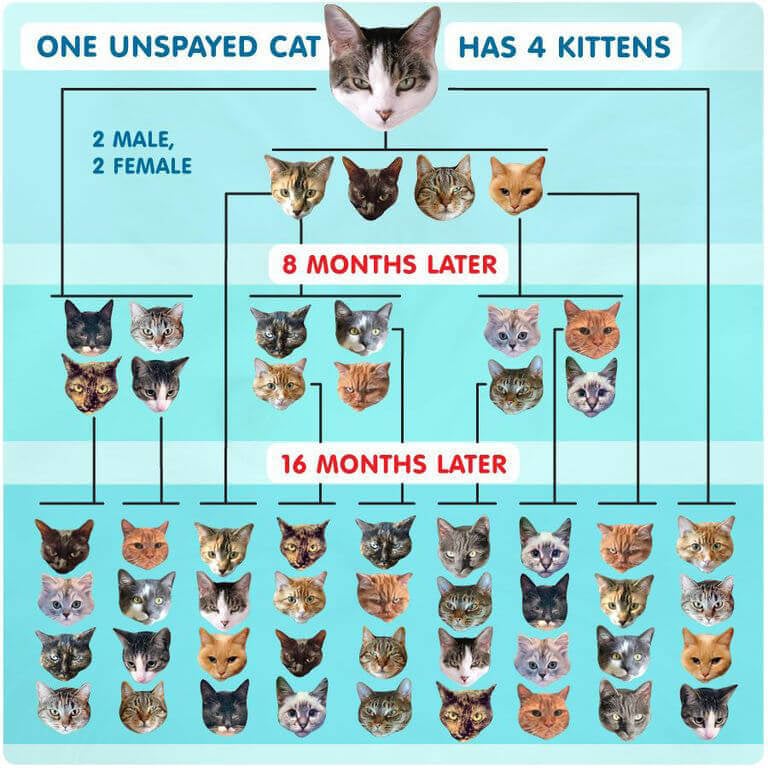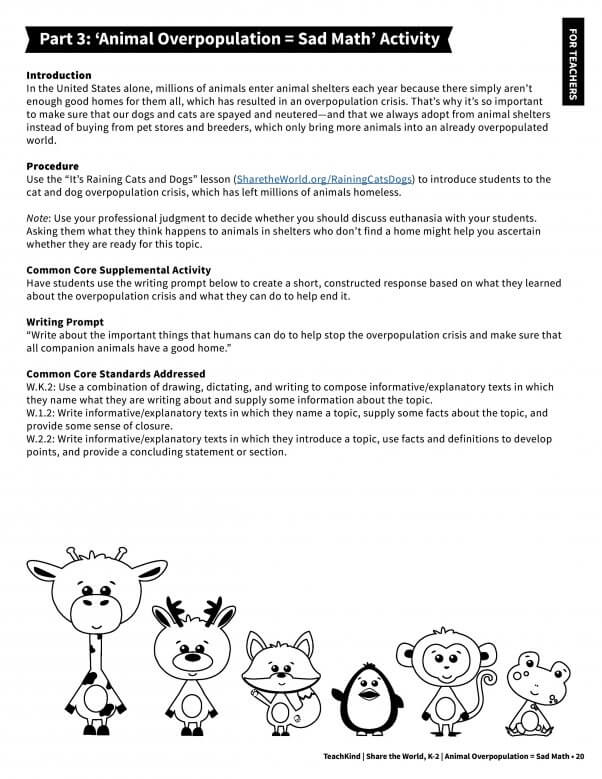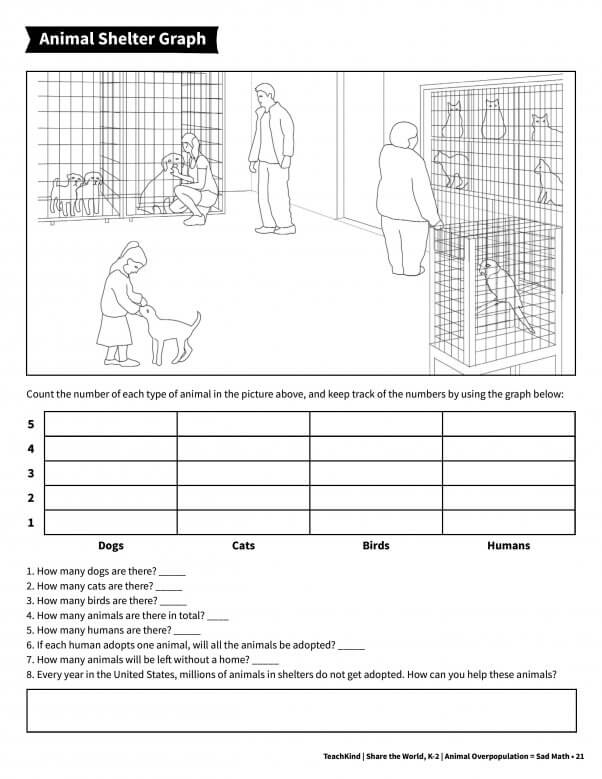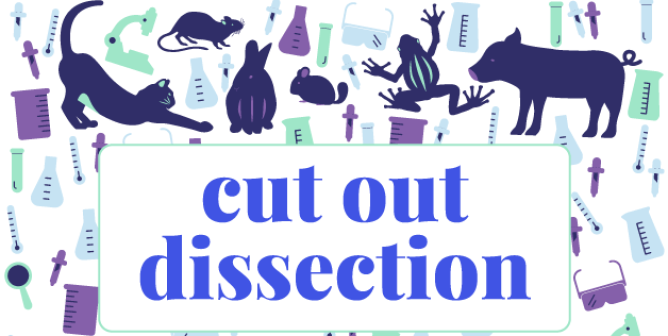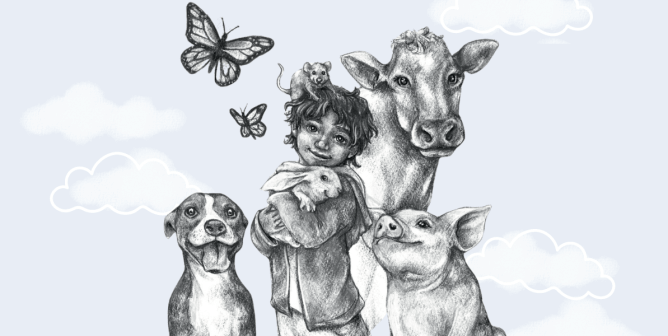It’s Raining Cats and Dogs (Grades K-2)
This lesson plan is designed to help teachers present animal rights issues to their students. If you’re an educator, please feel free to adapt this material to fit your needs, and contact us if you need help incorporating this activity into your curriculum.
Kids love cats and dogs—but large numbers of them can be too much of a good thing. Because some people neglect to have their animal companions spayed or neutered, we’re now facing a severe overpopulation crisis in which millions of animals are left homeless.
In fact, every year in the U.S., more than 6 million lost, abandoned, or unwanted dogs and cats end up at animal shelters and approximately half of them (including many who are healthy, young, and adoptable) must be euthanized because of a lack of good, permanent homes.
But we can all make a difference, because the single most important thing that humans can do to prevent the suffering and death caused by companion animal overpopulation is to have cats and dogs spayed or neutered. Sterilization surgery is a routine, safe, and affordable way to keep thousands of animals from being born into an already overpopulated world.
It’s important to teach students why sterilization is the most compassionate solution to the homeless-animal crisis. Use the following activity to help teach these lessons in an age-appropriate way.
Discussion and Introduction
Begin this lesson by sharing an experience that you’ve had with a cat or dog or by telling students about your animal companions. Ask students to share what they love about their own animal companions (or another cat or dog they know). Discuss the many ways animal companions enrich our lives, and talk about the great responsibility we have for caring for them. For example, they need plenty of playtime, food, and love.
Consider the following facts and discuss them with your students:
- Every year, more than 6 million animals in the U.S. end up at shelters, where they have to wait to be adopted. This amounts to an overpopulation crisis.
- There simply aren’t enough good homes available for all these animals, so approximately half of them will be euthanized.
Such large numbers can be confusing and unclear to K–2 students, so it’s helpful to illustrate them using a visual element. Draw six stick-figure dogs and cats on the board and place a square around them. Explain that these six animals are homeless, were taken in by an animal shelter, and are waiting to be adopted by a family. Then draw three houses or people. Explain that even though there are six dogs and cats, there are only three families looking for one animal each to adopt. That means that only three of these animals will leave the shelter and be taken into a home. If appropriate, explain that after a while, some animals have to be euthanized because the shelter must make room for others who are also trying to find homes.
Then ask students to imagine multiplying each of these six animals by a million—this doesn’t just happen to six animals but rather to 6 million (or more) each year. You can help students grasp the concept of this huge number by telling them that a million is the approximate number of people who live in the whole state of Montana, Rhode Island, or Delaware. Finally, explain that the very best thing that we can do to help end this crisis is to prevent more dogs and cats from being born by always having our animal companions spayed or neutered.
Show your students this graph to help demonstrate how one unspayed cat and her kittens can lead to the births of 370,000 cats in just seven years:
And let students know that one female dog and her puppies can result in the births of 67,000 dogs in just six years. Next, have them create their own infographic (modeled on the images shown here) to display this information. The most important thing here is that students show they understand the concept that one unspayed dog or cat can result in many births in only a few years.
Animal Overpopulation = Sad Math
For the math portion of this lesson, print this worksheet and teacher’s guide (which can also be found on pages 20 and 21 of TeachKind’s “Share the World” activity sheets for grades K–2):
If the math is too advanced, put the worksheet up on a projector and work through it together as a class. Follow the instructions in the teacher’s guide as you teach this lesson (and if you’re working through the “Share the World” curriculum kit, you can tie this lesson in with the video as well).
Video Comprehension
Show students the following animated video, “370,000 Reasons to Spay and Neuter.”
After you show the video, project or write the following comprehension questions on the board. Show the video again once students have access to the questions so they can answer more accurately. (The video is under two minutes.)
- What happens when there aren’t enough homes for all the homeless animals in shelters?
Answer: Some animals won’t be adopted.
- If animals don’t have homes, where do they end up and what can happen to them?
Answer: Homeless animals can end up in shelters and could be euthanized if they’re not adopted, or they could end up living on the street and being in danger.
- What is something that people can do for their animals to help control the population of homeless cats and dogs?
Answer: Have their animals spayed or neutered.
- Besides reducing the number of homeless dogs and cats, what are some other ways spaying and neutering helps companion animals?
Answer: Sterilization helps prevent certain forms of cancer, helps prevent male cats from running away, and helps animals live longer.
- If someone can’t afford a spay/neuter surgery, what can they do?
Answer: Look for a low- or no-cost clinic, or call 1-800-248-SPAY.
- Explain what can happen if a single kitten isn’t spayed.
Answer: An unspayed kitten can grow up and have babies, and her kittens can do the same, and so on—eventually resulting in thousands more kittens within just a few years.
Finally, let your students know that in addition to having animal companions spayed or neutered, they can also help save the lives of cats and dogs by adopting them from shelters and never buying them from pet stores or breeders!
*****
By teaching young people to treat all sentient living beings as the individuals they are, we can cultivate a positive classroom culture, celebrate diversity, and foster prosocial growth in our students, while also reducing bullying and violence in our schools and communities. TeachKind’s free lesson plans can help.


